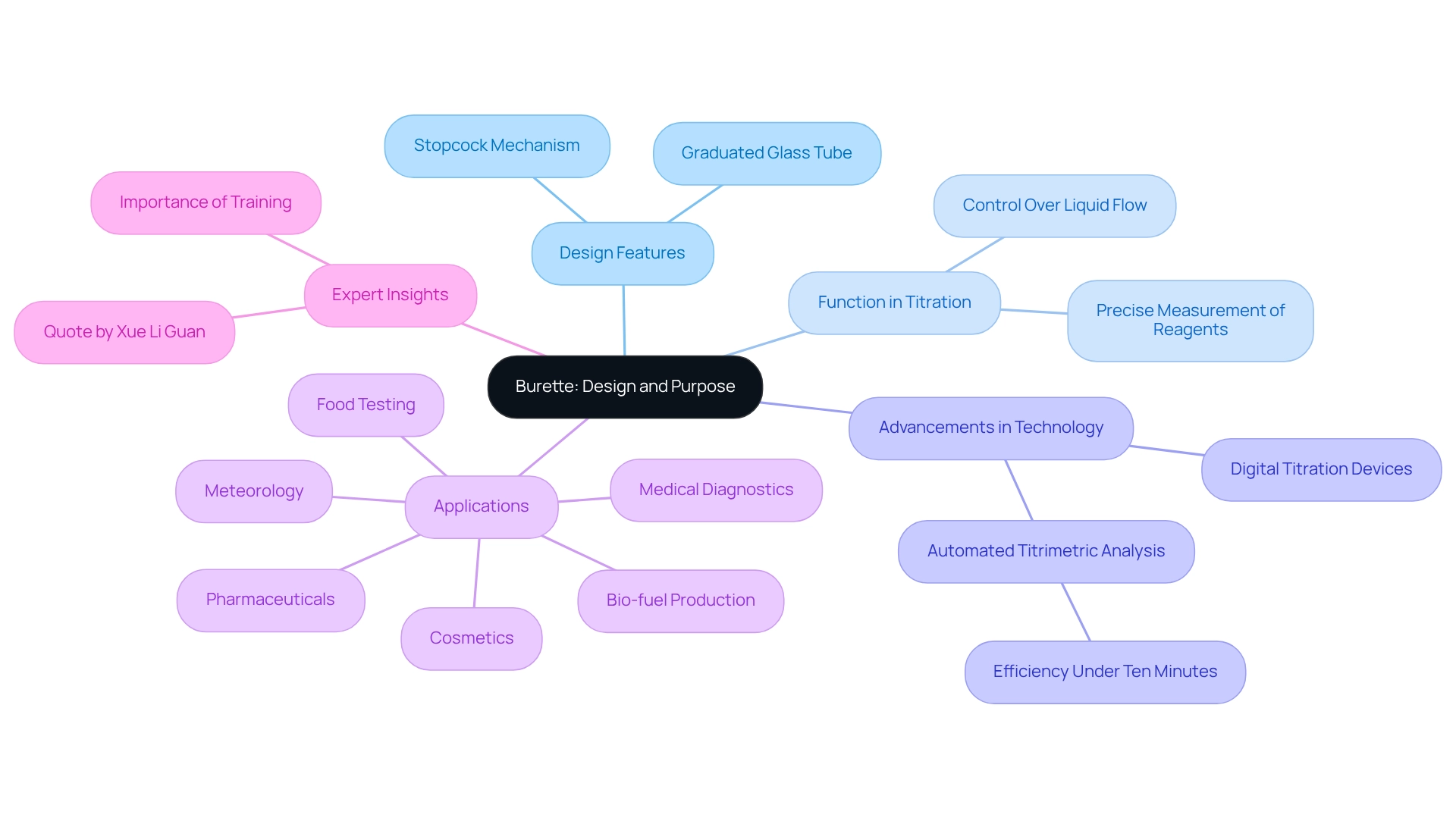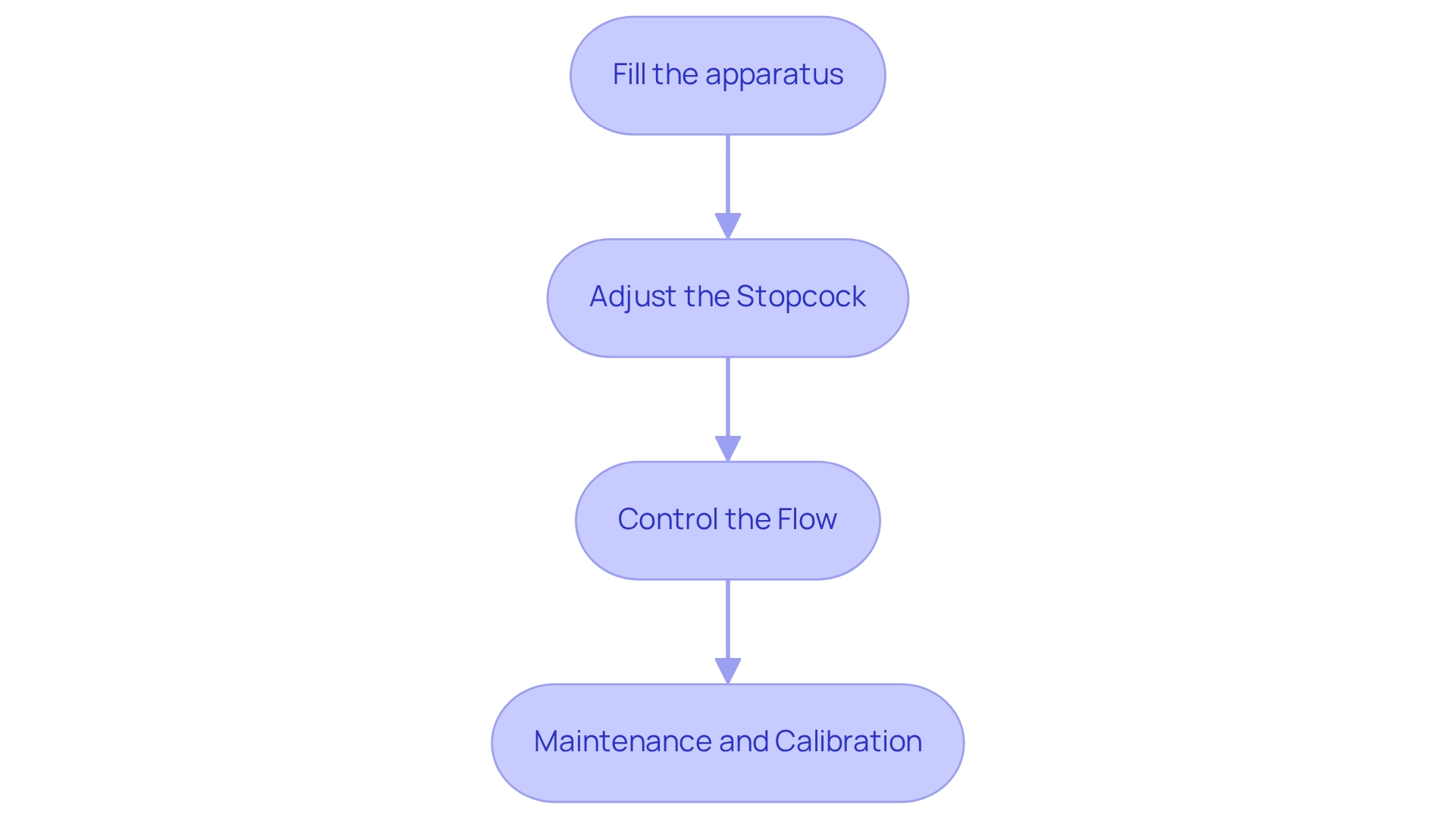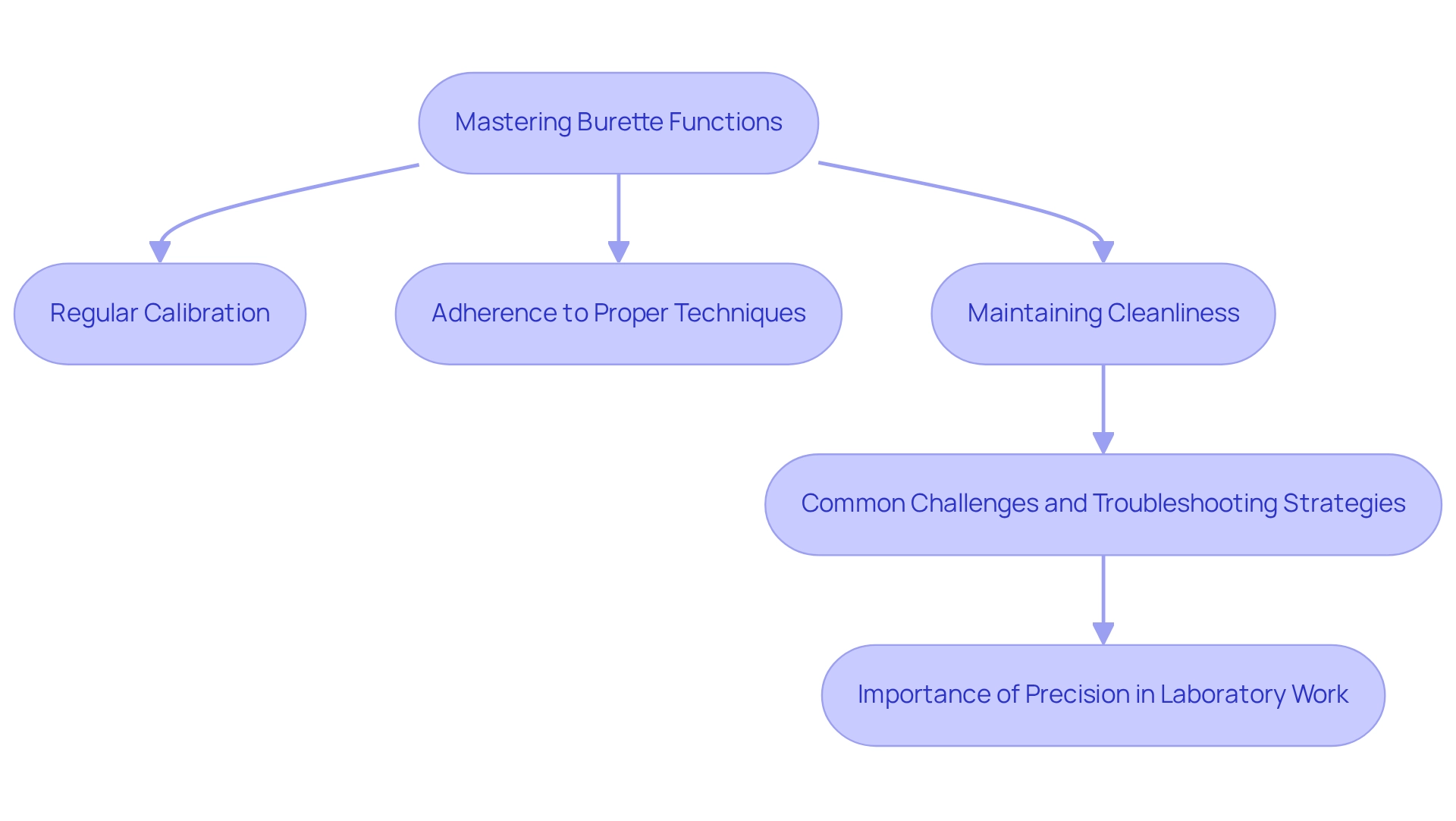Overview
This article delves into the essential functions and significance of burettes in laboratory applications, with a particular focus on their role in titration processes. Burettes are indispensable tools for achieving precise liquid measurements in quantitative analysis. Even minor discrepancies in measurement can lead to significant variations in experimental outcomes, underscoring their critical importance in fields such as pharmaceuticals and chemistry. By ensuring accuracy, burettes help maintain the integrity of scientific research and experimentation, which is vital for advancing knowledge in these domains.
Introduction
In the realm of laboratory science, precision is paramount. At the heart of accurate liquid measurement lies the burette—a tool that has become indispensable across various fields, including chemistry and pharmaceuticals. This graduated glass tube, equipped with a stopcock, facilitates the meticulous dispensing of liquids, making it essential for titration processes where every drop counts.
As technological advancements introduce digital and automated options, the versatility and functionality of burettes continue to evolve, catering to the increasing demands for accuracy and efficiency in laboratory settings. Understanding the different types of burettes and mastering their operation reveals how these instruments underpin the reliability of experimental results and the integrity of scientific research.
What is a Burette? An Overview of Its Design and Purpose
A graduated glass tube with a stopcock at one end serves the burette function of dispensing accurate volumes of liquid. This function plays a crucial role in titration processes, where the precise measurement of liquid reagents is essential for achieving reliable results. Characterized by a long, slender body marked with volume graduations, the burette allows users to measure and control the flow of liquid with exceptional precision.
In laboratory settings, particularly within the fields of chemistry and pharmaceuticals, the importance of precision cannot be overstated. The burette function is essential for quantitative analysis, as it allows for meticulous control over the addition of titrants during experiments. This precision is vital, as even minor discrepancies in measurement can lead to significant variations in experimental outcomes.
Recent advancements in titration device design have further enhanced their functionality. Digital or are now suggested for individuals pursuing additional accuracy, especially in intricate titrimetric assessments. Automated titrimetric analysis of tablet composition can be completed in under ten minutes, highlighting the efficiency and precision that contemporary measuring devices can offer.
This is particularly relevant when using advanced titration systems like the AQ-300 Coulometric Karl Fischer Titrator and the AQV-300 Volumetric Karl Fischer Titrator from JM Science, designed for drug and medicine testing in compliance with the Japanese Pharmacopoeia.
The adaptability of these measuring devices extends beyond conventional chemistry uses; they are employed in numerous sectors, such as pharmaceuticals, food testing, cosmetics, meteorology, bio-fuel production, and medical diagnostics. Case studies demonstrate their essential function in guaranteeing precise evaluations and analyses across these varied domains, emphasizing the importance of high-quality delivery system design. For instance, the case study titled 'Uses of Burettes' highlights the burette function in quantitative analysis and titration, underscoring its significance in ensuring accurate measurements across multiple scientific fields.
Expert views emphasize that the design of a measuring device must prioritize accuracy to meet the stringent requirements of scientific applications. As industry professionals note, Xue Li Guan states, "Possession of any skill, even a common one such as pipetting, and understanding of a technique should not be assumed, and training and evaluation of performance need to be in place." This underscores the significance of adequate training and assessment to guarantee efficient use of measuring devices in scientific environments.
In summary, the design and purpose of the burette function are essential to experimental applications, making it a fundamental tool for achieving accuracy in scientific research. Its role in titration processes illustrates the broader significance of precision in experimental measurements, which is essential for advancing research and ensuring quality in various scientific fields, especially in the pharmaceutical industry where the burette function of JM Science's innovative titration solutions plays a pivotal role. Furthermore, JM Science provides an extensive selection of scientific instruments, including HPLC solutions and accessories, which further enhance research capabilities.
For more information on pricing and purchasing options for the AQ-300 and AQV-300 titrators, visit JM Science's e-commerce platform.

Types of Burettes: Exploring Different Varieties and Their Uses
In laboratory settings, a variety of burettes are employed, each specifically designed to address .
The Volumetric Device stands out for its precision, making it the standard selection for titration tasks. Typically featuring a capacity of 50 mL, it is equipped with fine graduations that facilitate accurate liquid measurement, thereby playing a crucial role in quantitative analysis.
Next, the Digital Dispensing Device offers advanced functionality with electronic displays that simplify value readings. Many digital models come with automatic dispensing features, significantly enhancing efficiency in the laboratory and reducing the likelihood of human error during liquid transfers. The impact of digital titration devices on laboratory efficiency is profound, as they streamline workflows and improve precision in evaluations.
The Piston Dispenser, akin to a syringe, allows for meticulous control over the dispensed volume. This type proves particularly beneficial when handling viscous liquids, ensuring accurate and consistent measurements.
Finally, the Automatic Dispenser is tailored for high-throughput environments, featuring mechanisms that enable controlled dispensing without manual intervention. This design is ideal for repetitive tasks, thereby optimizing workflows in busy laboratories.
The choice of dispensing device is influenced by several factors, including the required precision, user-friendliness, and the characteristics of the liquid being measured. With the rising demand for high-precision measuring devices, particularly in the pharmaceutical and biotechnology sectors, understanding these various types and their applications is vital for enhancing operational efficiency. Industry insights indicate that the demand for high-precision burettes is projected to grow significantly, reflecting an ongoing evolution in burette functionality and a commitment to innovation and sustainability.
As emphasized by a US TPS Business Development Manager at Thermon, "The response was good, and I got what I was looking for as far as the report. Thank you for that," highlighting the critical role of reliable measurement tools in testing environments.
How Burettes Work: Understanding the Mechanism of Liquid Dispensing
The function of a burette is grounded in a straightforward yet efficient principle, primarily governed by the stopcock located at the bottom. This mechanism facilitates precise liquid dispensing, which is essential in various laboratory applications, particularly in pharmaceuticals. To effectively utilize a burette, follow these steps:
- Fill the apparatus: Securely mount the device in a stand and fill it with the liquid intended for dispensing. It is crucial to ensure that no air bubbles are trapped in the nozzle, as this can lead to errors in measurement.
- Adjust the Stopcock: Open the stopcock to initiate the flow of liquid. The graduations marked on the burette offer a clear indication of the volume dispensed, enabling precise measurements.
- Control the Flow: By carefully adjusting the stopcock, users can regulate the flow rate. This control is vital for achieving the desired endpoint in volume measurement experiments, where precision is paramount. A common application in pharmaceutical settings is redox titration, which involves a redox reaction to determine the concentration of an analyte.
The design of the stopcock significantly influences the accuracy of liquid dispensing. A well-designed stopcock minimizes user errors, which is essential in environments where precision is critical. Jakob Nielsen, a prominent figure in the UX industry, asserts, "testing with five individuals is the sweet spot," underscoring the importance of user interface design in reducing mistakes associated with measuring devices.
Research indicates that user error rates can be mitigated through careful design and usability testing, highlighting the necessity of ergonomic and intuitive interfaces in scientific instruments.
A case study focusing on the maintenance and calibration of volumetric flasks revealed that regular cleaning and recalibration are crucial for ensuring precise titration results. Adhering to a maintenance schedule not only preserves the quality of laboratory testing outcomes but also ensures compliance with industry regulations. This emphasizes the importance of understanding and the significance of its components in achieving reliable results in quantitative chemical analysis, particularly within the pharmaceutical industry.

Applications of Burettes in Laboratory Experiments: A Focus on Titration
The function of the burette is crucial in the measurement process, a quantitative analytical technique essential for determining the concentration of unknown solutions. The titration process involves several key steps:
- Preparation: The device is filled with a titrant of known concentration, ensuring accuracy in subsequent measurements.
- Titration Process: The titrant is carefully dispensed into the analyte solution until the reaction reaches its endpoint, typically indicated by a distinct color change or another measurable signal.
- Measurement: The exact volume of titrant used is meticulously documented from the dispensing device, enabling precise calculations to ascertain the concentration of the unknown solution.
This method is not only essential in chemistry but also has applications in biology and environmental science, underscoring the burette's function as a critical instrument in research environments.
Expert insights emphasize the significance of precise measurement in pharmaceutical laboratories, where accuracy is paramount. Research has demonstrated that more than 75% of unidentified chloride salts were correctly recognized by students using a combination of qualitative analysis and silver nitrate measurement. This statistic highlights the effectiveness of in ensuring reliable results, which is critical in pharmaceutical applications where accurate concentration measurements can impact product quality and safety.
In a practical application, an experimental study titled 'Studying Equilibrium in Chemical Reactions' utilized argentometric analysis to examine the burette's function in determining the balance between ferric and iodide ions. This case study demonstrated how measurement techniques can enhance students' comprehension of chemical equilibrium principles and their practical applications, particularly in drug formulation and quality assurance in pharmaceutical settings.
Current trends in titration methods emphasize the integration of technology, such as JM Science's LabX™ Titration software, which connects instruments and accelerates titration analyses through electronic data flow. This innovation not only guarantees adherence to regulatory standards but also increases operational flexibility, enabling pharmaceutical facilities to streamline processes and enhance efficiency. Additionally, JM Science provides a comprehensive range of products, including Karl Fischer reagents and HPLC columns, which further support scientific functions and enhance analytical capabilities.
Moreover, repeating experiments in acid-base procedures is essential for error detection, enhancing precision, validating statistical outcomes, and building confidence in findings. This practice is particularly crucial in pharmaceutical facilities, where even slight discrepancies can lead to significant consequences in drug development and testing. As Richard P. Feynman aptly noted, "The great part of science is different kinds of experimental art to make things right," highlighting the creativity involved in achieving precise results through careful measurement techniques.
In summary, the uses of these measuring devices in titration and quantitative analysis are extensive, making them essential for pharmaceutical facilities aiming for precision and reliability in their analytical processes. JM Science Inc. offers a range of premium titrators, Karl Fischer reagents, HPLC columns, and accessories that support these critical laboratory functions. For more information on our products, visit JM Science's website.
Ensuring Accuracy: Best Practices for Using Burettes in Measurements
To ensure precision when utilizing a titration device, it is essential to adhere to the following best practices:
- Calibration: Regular adjustment of the device is crucial to guarantee that it dispenses the correct volume. This is particularly important for digital and automatic devices, as are vital for providing reliable outcomes and minimizing troubleshooting expenses. Effective calibration is essential for delivering trustworthy patient results, especially in pharmaceutical settings where precision is critical.
- Proper Technique: Always read the burette function at eye level to avoid parallax errors. Precise readings should be taken from the bottom of the meniscus, ensuring accuracy in volume assessments. As noted by E. Wilkinson, due to the limited capacity, appropriate technique is essential for precise evaluations without introducing errors. Furthermore, maintaining a clean burette is critical for proper function. Residues from previous solutions can contaminate new samples and significantly affect measurement accuracy. A clean instrument is vital for dependable outcomes in research environments, particularly in pharmaceutical facilities where contamination can lead to considerable research delays.
- Avoid Air Bubbles: Before commencing titration, check for and eliminate any air bubbles in the burette tip. Air bubbles can interfere with the burette function, resulting in inaccurate volume readings and compromising the integrity of the experiment. For instance, the case study on an electrostatic voltmeter emphasizes the significance of accurate testing methods, which can be compared to the use of burettes.
By adopting these best practices, staff can significantly enhance the dependability of their readings and improve the overall quality of their experimental outcomes. Regular calibration and attention to cleanliness not only ensure accuracy but also align with expert recommendations for maintaining laboratory instruments. Moreover, understanding the normal range of indication for instruments, such as the electrostatic voltmeter's range of 6 to 30 kilovolts, adds a quantitative aspect to the discussion on measurement accuracy, reinforcing the importance of these practices in pharmaceutical research and development.
Common Challenges and Troubleshooting Tips for Burette Use
Common challenges encountered when utilizing volumetric devices include:
- Slow Flow Rate: This is a frequent issue that may arise from clogs or trapped air bubbles. To address this, inspect the stopcock for any obstructions and clean the measuring device thoroughly. Regular maintenance is essential to prevent these blockages.
- Inaccurate Readings: Accurate measurement is vital in laboratory settings. Ensure that readings are taken at eye level and from the bottom of the meniscus. If discrepancies persist, adjusting the apparatus may be necessary to regain accuracy.
- Dripping After Use: Should the apparatus continue to drip post-operation, it may indicate wear or damage to the stopcock. Inspect this component closely and replace it if any defects are found to maintain proper functionality.
To prevent contamination during the burette function, always rinse it with the solution intended for use before filling it. This practice is crucial for maintaining the integrity of experimental outcomes.
Addressing these challenges proactively can significantly enhance the precision and reliability of research operations. A case study on safety in research facilities highlighted that adherence to established safety protocols and not only improved safety but also boosted productivity. This underscores the importance of keeping tools such as pipettes in optimal condition.
Moreover, expert opinions suggest that consistent training on the correct usage and maintenance of pipettes can further mitigate these frequent issues, ensuring that staff are well-prepared to tackle any difficulties that arise during experiments. Additionally, it is vital to establish emergency protocols for situations such as spills or health crises, ensuring that clear communication guidelines are in place. Utilizing appropriate apparatus, such as , is critical for procedures at reduced pressure, which can further enhance safety when employing measuring devices.
As noted by OSHA, in 2018, over $3.5 million in penalties were imposed for laboratory safety violations in the United States alone, emphasizing the necessity of adhering to safety standards in research environments. Furthermore, the implementation of microwave ovens with integrated safety features can mitigate risks, highlighting the significance of safety in all equipment usage, including volumetric flasks.
Key Takeaways: Mastering Burette Functions for Effective Laboratory Work
Mastering the use of a graduated cylinder is essential for achieving accuracy in experimental tasks, particularly during titration procedures. A burette, as a precision instrument specifically designed for the accurate dispensing of liquids, is indispensable in quantitative analysis. Various titration devices, including manual and digital options, cater to diverse experimental requirements, allowing for flexibility in laboratory applications. A comprehensive understanding of the liquid dispensing mechanism is crucial for ensuring accurate measurements, which directly impacts the reliability of experimental results.
Best practices for effective burette function include:
- Regular calibration
- Adherence to proper techniques
- Maintaining cleanliness to prevent contamination
As Sasha Kaesermann, Head of Laboratory Service, states, "Calibration helps prevent these issues by ensuring consistent, accurate results, which enhances a lab's credibility."
Familiarity with common challenges and troubleshooting strategies can significantly enhance operational efficiency in research environments. By implementing these best practices, staff can elevate their analytical capabilities, leading to more successful and reliable experimental outcomes. Moreover, as research facilities increasingly embrace advanced technologies, such as those arising from nanotechnology, the significance of mastering tools like pipettes becomes even more evident. The anticipated use of nanotechnology in clinical settings is set to enhance testing efficiency and precision, paving the way for .
Furthermore, the evolution of test result transmission from the 1980s, when results were frequently dispatched by courier or mail, to today's automatic electronic forwarding underscores the essential role of accurate instruments like the burette in improving efficiency in testing environments. Understanding basic statistical controls and methods for quality assurance is also vital, aligning with the overarching theme of precision in laboratory work.

Conclusion
The significance of burettes in laboratory science is paramount. As precision instruments, they play a crucial role in accurate liquid dispensing, particularly in titration processes where even the smallest measurement can significantly impact experimental outcomes. Various types of burettes, including volumetric, digital, piston, and automatic models, are designed to address specific laboratory needs, thereby enhancing both accuracy and efficiency.
Understanding the functionality of burettes is essential for effective laboratory work. The mechanism of liquid dispensing, regulated by a stopcock, allows for meticulous flow control, which is vital in achieving desired results in quantitative analysis. Best practices such as regular calibration, maintaining cleanliness, and employing proper techniques further ensure the reliability of measurements, emphasizing the necessity for rigorous standards in laboratory environments.
Moreover, addressing common challenges associated with burette use—such as slow flow rates and inaccurate readings—is critical for maintaining operational efficiency. Troubleshooting tips and expert insights underscore the importance of training and maintenance, ensuring that laboratory personnel are well-equipped to manage potential issues effectively.
In conclusion, mastering the use of burettes is integral to achieving precision in laboratory experiments. As technology continues to advance, the importance of these instruments will only increase, underpinning the reliability of scientific research and the integrity of results across various fields, particularly in pharmaceuticals. By prioritizing best practices and understanding the functionalities and challenges of burettes, laboratories can enhance their analytical capabilities and contribute to the advancement of scientific knowledge.




